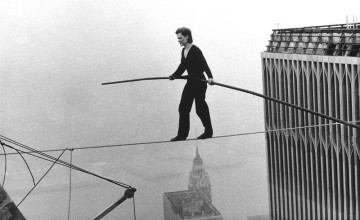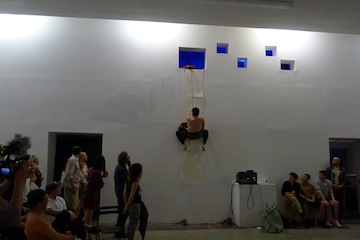
Philippe Petit, a French high wire artist, walks across a tightrope suspended between the World Trade Center's Twin Towers. New York, Aug. 7, 1974. AP Photo by Alan Welner.
When I was a kid my grandmother took me to visit her hundred-year-old aunt in a nursing home in Phoenix, Arizona. I was hopelessly bored for several days. Wandering around the facilities, I kept seeing a jacuzzi I wasn’t supposed to go into. (It was calling my name). Finally, overwhelmed by the boredom, I got the idea…wouldn’t it be funny to pretend to be dead at the bottom of the jacuzzi?
My grandmother was nearby when I quietly crept into the super hot water and sprawled out on the bottom of the jacuzzi. I timed my fake death perfectly because the next thing I saw from underwater was my grandmother leaning over the edge, and when I couldn’t hold my breathe anymore I shot out laughing….
I felt bad later.
The first time I saw Dawn Kasper playing dead it brought me back to that memory. Dawn was a scarecrow on the ground with a pitchfork sticking straight out of her chest. It was scary and hilarious. For years, Dawn could be spotted, dead, at art events all over Los Angeles, in the tradition of Harold and Maude, sprawled out in an elaborate shrine to some horrific accident. Holding court in death while all the socializing and partying swirled around her.
When I think about what I did to my grandmother (an act for which I’m still not forgiven), and what Dawn continues to do, I’m aware of the primal impulse to try something out and see what happens, to see what it might be like if someone thinks I’m dead or am about to die. There’s really nothing more exciting than to go right up to the precipice and look over. In that territory, however, we move away from the world of pure performance and into a territory which is complicated and challenged by the idea of a “prank.”
The history of action-as-performance–the traditions of Fluxus artists and specifically Chris Burden, Vito Acconci and Yoko Ono–is frought with the consideration of finding the difference between prank and performance. Dawn Kasper is entering into the history of this question. I believe that there doesn’t have to be a difference between a prank and performance as long as it is done well. I think the greatest performance of the 21st Century by any human being is Philippe Petit’s tightrope crossing of the Twin Towers. And I don’t care whether or not this was announced as a Fluxus work or any sort of performance. It all comes down to one thing, which I think is the same across all mediums: to have the fantasy and to carry it out.
If it is done well, the performance becomes timeless and it enters history. And in order for it to be carried out well, I believe the performer has to go all-out and never take the audience for granted.
Dawn is slowly and steadily mastering these two things. It’s what takes her performances into the realm of pure fantasy enacted in real time, as a gift to all. She sacrifices herself to the space of performance. Recently in New York (at the Festival of Ideas organized by the New Museum in which artists took over an old schoolhouse) she carried out another one of my personal childhood fantasies. Standing in front of the classroom as though she was a teacher, she chalked on the blackboard the words “Clarity” “Gilda Radner” “Richard Pryor” “Freedom From Self” and then just sputtered out of control, jumping onto the desk with a buzz saw that suddenly appeared out of nowhere. Then, while everyone watched breathlessly, Dawn stood on the desk and violently hacked it into pieces, until she stood, teetering. As she got to that last moment where really something bad could have happened, I realized that Dawn was actually in a position where her audience was truly a witness to a potential act of violence. “Oh man…don’t hurt yourself…” I kept thinking. I was also aware of my own sense of “what do I do if Dawn DOES hurt herself? Should I have my phone out with 911 ready to press? Should I go over there? Should someone unplug the cord?” And out of total respect for Dawn and her work I stood dumbly, like a confused bystander, the way I believed I should, and then exhaled when it all ended okay.
Dawn’s piece immediately reminded me of one of my favorite school fantasies that I had long forgotten about. I always hoped that one of my teachers would go crazy in front of me and self-destruct. I also had my own fantasy of going crazy in a class and causing mayhem. But whereas kids like Dylan Klebold and Eric Harris really did it, Dawn gives the audience some sense of knowing what it may feel like to be there when something like that is happening. In a strange way perhaps she’s also giving herself the experience of knowing what that feels like, to be the kid that does the deed. I feel like this is what performance is all about.
Dawn is an anti-hero. She’s also a very old-school performer. I think of Dawn as almost a throwback, not just to Houdini but to the medieval times where jousters publicly die. The possibility of death in Dawn’s performances is always there, and it’s something I appreciate about her work. Not because I want to see her go to the brink of death and prove that she survived, but because she reminds me that the performance/audience relationship is sacred.
Even when the audience sucks, even when the performance sucks, when everyone is hateful and your performance is bad, that relationship is still sacred. Even if it’s just three people who are comatose in wheelchairs (I’ve performed for this audience), that relationship can’t be taken for granted. If that bond is taken for granted, the performance is over–at least it is for me. I think Dawn’s performances ride that line between success and failure, sometimes so closely that the entire show exists in order to see how this experiment plays out–and you just hope no one gets hurt. Dawn offers this to the audience, the gift of a true surprise. There isn’t a lot of planning. It’s just Dawn, and it’s just you watching her, and what happens will be the thing you get to keep for the rest of your life. GG Allin would tip his hat to her if he were still alive.
It’s true, Dawn can also create spectacular failures, which is the mark of a great artist. But what seems to me to separate Dawn from other artists is that she doesn’t invent a fantasy character, she actually performs as herself, albeit an exaggerated version of herself. But it is Dawn on display in her work. And it’s scary. A lot of performers put versions of themselves out there–I know I do–but Dawn does the thing directly to herself, with herself, permanently, and it is forever inscribed on her. It’s frightening, it’s troubling, and it’s heroic.







Pingback: Flavorwire » Your Must-See Cheat Sheet for the Whitney Biennial 2012
Pingback: My Blog » » Your Must-See Cheat Sheet for the Whitney Biennial 2012